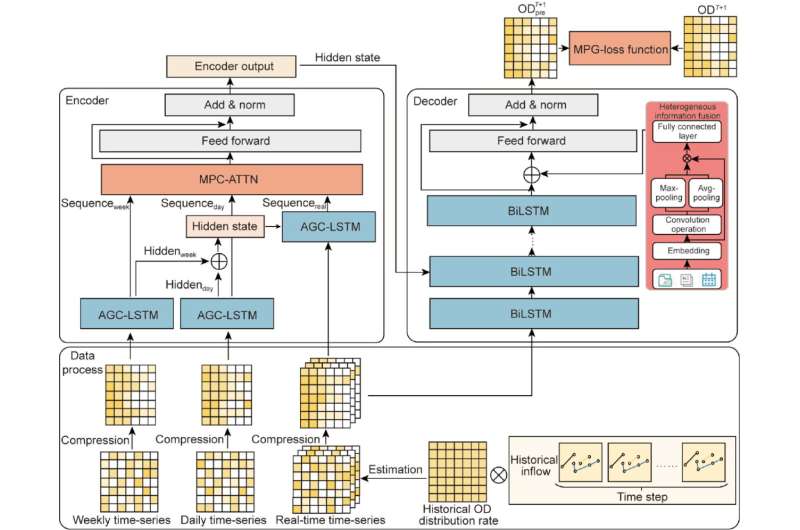
JULY 17, 2024 by Engineering
Collected at: https://techxplore.com/news/2024-07-urban-rail-transit-demand-high.html
In a recent study published in Engineering, a research team led by Jinlei Zhang from Beijing Jiaotong University, China, introduces a pioneering model that addresses the complex challenge of short-term origin-destination (OD) demand prediction in urban rail transit (URT) systems, particularly under the strain of a pandemic.
The study presents the Physics Guided Adaptive Graph Spatial-Temporal Attention Network (PAG-STAN), a unified framework that not only forecasts with remarkable precision but also enhances model interpretability, a crucial factor for urban planners and transit operators.
The accurate prediction of OD demand is essential for the efficient operation and management of URT systems. Traditional methods have struggled with real-time data availability, data sparsity, and high-dimensionality issues, all exacerbated by the unpredictable nature of a pandemic.
The PAG-STAN model, however, rises to these challenges, offering a robust solution that integrates real-time OD estimation, dynamic demand matrix compression, and a masked physics-guided loss function (MPG-loss function) to improve training efficiency and interpretability.
The research introduces a real-time OD estimation module capable of estimating complete OD demand matrices in real-time, a significant advancement given the sparsity often encountered in raw metro data. Furthermore, the dynamic OD demand matrix compression module is a novel approach that generates dense matrices by focusing on high-demand OD pairs, thereby preserving crucial distribution information while tackling sparsity and high dimensionality.
At the heart of PAG-STAN lies an encoder–decoder architecture that captures the intricate spatial–temporal dependencies of metro OD demand. The model employs an Adaptive Graph Convolution Long Short-Term Memory (AGC-LSTM) and a Multi-Periodic Cross-Attention Mechanism (MPC-ATTN) to understand the periodicity and spatial-temporal distribution of OD demand.
Bidirectional LSTMs (BiLSTMs) propagate contextual messages, while a Heterogeneous Information Fusion Block (HIFB) incorporates diverse data sources, including pandemic-related and date-attributed data, to assess the impact of external factors on OD demand.
A standout feature of PAG-STAN is the MPG-loss function, which embeds the physical quantity relationship between OD demand and inbound flow into the model’s training process. This innovation not only maintains the model’s predictive accuracy but also significantly improves its interpretability.
The study’s rigorous testing on two real-world datasets, one under pandemic conditions and another in conventional scenarios, demonstrated PAG-STAN’s superiority over existing methods. The model’s performance was consistently robust, highlighting its potential to revolutionize URT system management in times of crisis and calm alike.
While the study acknowledges limitations, such as the loss of relative position information due to the dynamic OD demand matrix compression, it also outlines a path for future research. The team at Beijing Jiaotong University is committed to refining the model, with plans to extend its application to other emergency scenarios, thereby enhancing PAG-STAN’s universality.
This research is a testament to the power of innovation in addressing complex, real-world challenges. As urban rail transit systems continue to be a lifeline for cities around the globe, the PAG-STAN model promises to be a vital tool for their efficient and effective management, especially in the face of unprecedented challenges like a pandemic.
More information: Shuxin Zhang et al, Physics Guided Deep Learning-based Model for Short-term Origin-Destination Demand Prediction in Urban Rail Transit Systems Under Pandemic, Engineering (2024). DOI: 10.1016/j.eng.2024.04.020

Leave a Reply